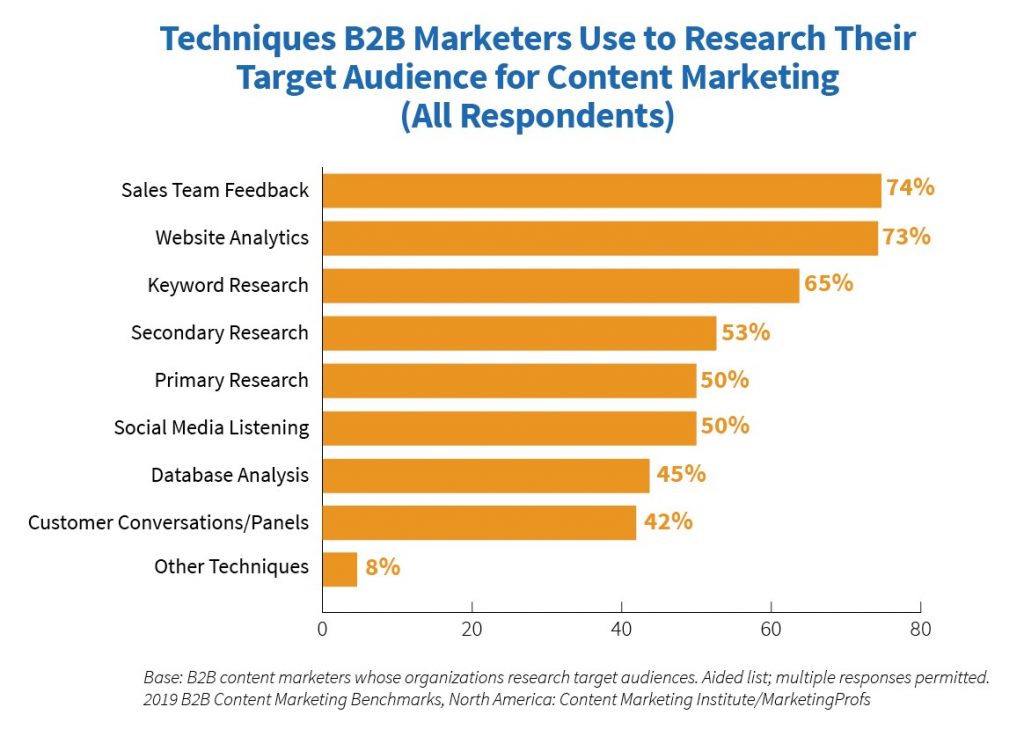 Know your audience has become a rallying cry behind the concept of creating compelling buyer and customer experiences and becoming customer-centric companies.
Know your audience has become a rallying cry behind the concept of creating compelling buyer and customer experiences and becoming customer-centric companies.
But how many B2B marketers can say they truly KNOW their customers?
For those of you who know me, you know I spend much of my time talking to my clients’ customers to do the research necessary to build buyer personas that can truly inform content marketing, product marketing and sales enablement programs.
I was sitting in a call with a group of marketers recently, reviewing a go-to-market plan. One of the key audiences they’d identified was line of business executives. Yet, the product is an IT product that will benefit first and foremost IT. It would never be purchased without IT involvement and approval.
It’s not unreasonable that business leaders might be involved, so I asked them to explain to me what the value is that will hook the business leaders and get them into a conversation about this product.
Complete silence.
They weren’t sure. But they just knew that business leaders would be involved.
Further discussion revealed that this “knowing” wasn’t informed by any customer conversations, it’s just the way they’d always done it or thought about how they take products to market.
Stuff like this is what we need to really start thinking about. Being me, the first thing I wanted to do was go talk to business leaders and find out if this would be a conversation that would interest them. Just because it didn’t make sense to me off the top, doesn’t mean that it couldn’t. My perspective isn’t their perspective, after all. This is why it’s important to have customer conversations.
And you know what they say about assumptions, right? But besides this, wouldn’t you be curious? Wouldn’t you want to know? I sure do.
Sadly, Customer Conversations are Not a Priority
One of the things that concerns me is the reliance on anything but direct customer conversations for 58% of marketers. Take a look at the bottom of this chart right before “other.”

At least research is being done, but here are some things to think about in relation to the top 4 sources consulted for audience insights:
Sales Team Feedback: One of the first things I do in a buyer persona project is interview members of the sales team to find out what they know about the market, what they hear on the street and why they think they win or lose deals. I also what to hear what the buying process is like for their buyers/customers.
[Note: I do this to gain a foundation of insight for the project, but also to involve sales and learn what they want to know that will help them buy into the persona project. You will need their buy-in to use personas successfully in your company.]
Sales does know their customers, but as you move from conversation to conversation with different salespeople, you do hear differences. These are based on the perspective and interpretation of the sales rep you’re speaking with. While it’s the most used type of research, marketers would do well to note that bias and interpretation is involved.
I’ve seen cases where what the reps have said lines up perfectly to what customers say, but those are not the norm. It’s not that sales reps are wrong, it’s that they use this information differently than a marketer will. They are involved in 1:1 conversations where they can shift on the fly based on what a buyer says, while marketers are usually addressing larger segments at once.
Website Analytics: Knowing which content on your website is visited by your prospects, buyers and customers is always useful for culling topics and trends and educational needs for buying. This said, knowing what they viewed and engaged with doesn’t tell you why they did so. I’d also argue that unless you can isolate who viewed the page (by persona or segment) then all you know is that the topic either resonated or didn’t.
What I’d look for beyond views and dwell time (did they spend enough time to read it?) is what they did next. Did they follow your CTA? Did they click on an embedded hyperlink or a sidebar offer? Or did they click on the navigation looking for something totally different?
Keyword Research: This is one likely all of us have done. It’s great to understand the words and phrases that our prospects use to search for solutions to problems they need to solve that we can help them with. This said, do we understand why they’re searching for those things or at what point in their buying process they use those words and phrases for search?
In conversations with customers, I’ve learned that what they start out searching for may not be what they end up searching for. As they learn more about solving the problem, they also search on new concepts they’ve discovered or things they’ve learned about in conversations with their network. It makes a big difference in how we tell the story across buying stages to know the when and how they came to search for a specific keyword or phrase.
Secondary Research: Reports about what buyers do or want come out what seems like every month these days. I find them all interesting (I’m a research geek) but I take them all with a grain of salt. Many B2B reports are based on inputs from 150 buyers. Most often these buyers hold various roles and come from companies of different sizes in different industries. Reports with bigger pools of buyers can span countries and regions, as well. It’s hard to get a true consensus with such a variant pool of respondents.
And, if you look at the way questions and answers are structured, quite often the surveys are designed to show the company who fielded the survey in the best light. Examples include options that would be reasonable to have in the choice selection but are not there, almost forcing the respondents to choose an answer favorable to the company by default. Feel free to use them (as I did above) but think about what’s not been asked, as well.
Data Can Be Misleading
The other thing that’s setting off alarm bells in my brain are the claims by predictive analytics companies that they can either build personas based on data they mine or provide you with lookalike audiences who will act like your ideal customers have in the past.
As I’ve said before, data is a wonderful tool. The problem with data is that it only shows the WHAT, not the WHY. Without the “why” do we really know what we think we know?
Go Talk to Your Customers
Marketers need to bite the bullet and go have customer conversations. There’s nothing like hearing from them in their words and understanding their thought processes and why they do what they do when researching and buying your product—or even why they chose not to buy from you.
Whether you formalize this information into personas or not is up to you. Buyer personas are a construct that help you apply what you’ve learned to consistently inform your go-to-market strategies, content marketing, product, and sales enablement programs.
They can also be used to inform your customer retention, cross and upsell programs, but you’ll be asking a different set of questions based on achieving different objectives.
B2B marketers have also said that lead gen is not the problem. Engaging those leads is what’s challenging. What you learn from talking with your customers can help change this, as well.
Oh, and the research quoted above also found out that 73% of B2B content marketers say they plan to use buyer personas by the end of 2018. I wonder what used to inform them…
Go forth and have customer conversations. What you’ll learn can transform your marketing programs from meh to awesome.
Hi Ardath – right on. Thanks for this well-reasoned post. When I moved from journalism to a marketing agency, I was surprised to discover large companies with hundreds of marketers who target CIOs, but never actually talk to them. That’s pretty odd! Another way to think about this is that a persona can’t tell you a story. If you want storytelling to be part of your marketing work, you’re going to have to set the data and personas aside from time to time and talk to a human being.
Hi Derek,
Thanks for your comment. However, I would point out that if you use customer conversations to inform your persona development then personas can indeed provide a foundation for storytelling. That’s the whole point.
Ardath
I am in full agreement, probably just being clumsy about it .
Excellent! 🙂